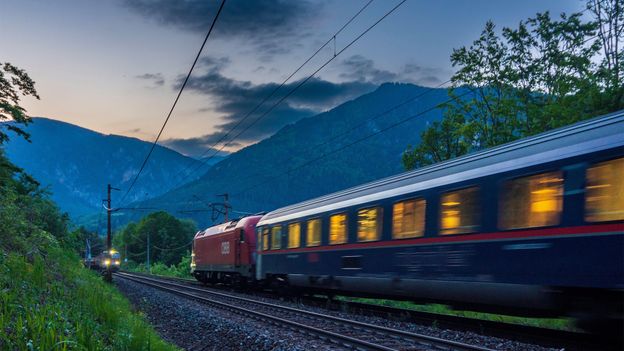By Joe Baur,Features correspondent
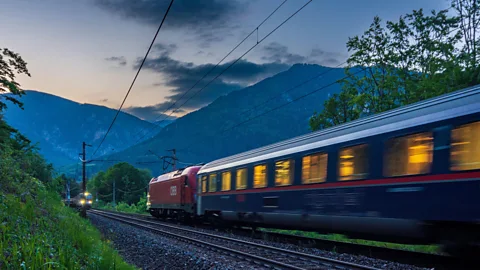 volkerpreusser/Alamy
volkerpreusser/AlamyHop aboard in one country, wake up in another and consider getting off to explore one of Germany’s most stunning landscapes.
In an era of cheap, low-cost flights, one throwback to the golden age of travel appears to be making a comeback: night trains. As a rail lover and carbon-conscious traveller, few things inspire me more than going to sleep in one country and waking up with a view of the countryside whizzing by, knowing that a different language and culture await me at the final stop.
That’s why I was excited to learn that, 10 months after launching its inaugural overnight service from Brussels to Berlin, the aptly named European Sleeper has recently expanded its service from Berlin to Prague. While the Brussels-to-Berlin service includes stops in Antwerp, Rotterdam and Amsterdam, the newly extended route now stops in Dresden and Bad Schandau in Germany, and Děčín, Ústí nad Labem and Prague in the Czech Republic. Travellers can choose from three ticket options: seated areas, couchettes and sleepers.
The European Sleeper is part of an ongoing renaissance in overnight European rail travel – spurred in part by the European Commission encouraging investment in night trains to help reach its climate objectives. In December 2023, Austria’s national railway, ÖBB, expanded its Nightjet sleeper train service to Berlin along its existing Vienna-to-Brussels route. After nearly a decade of suspended service, ÖBB and Germany’s national railway, Deutsche Bahn, also launched a new 15-hour Paris-to-Berlin overnight train in December. That same month, a new night train service relaunched between Paris and Aurillac in France after a 20-year hiatus.
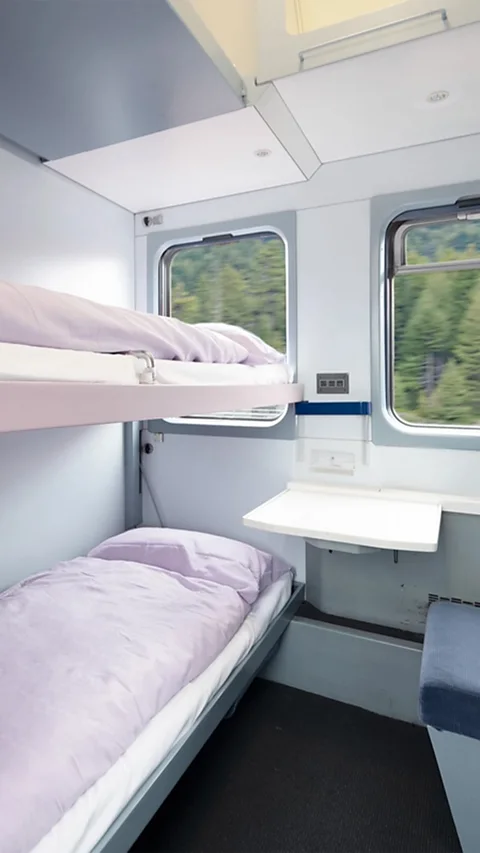 European Sleeper
European SleeperFor all their romanticism and charm, night trains remain a niche mode of transport. Long-distance trains are generally more expensive than many equivalent flights. And routes like the European Sleeper run just three times per week, whereas direct flights between capital cities often depart several times per day. Yet, aside from the environmental benefits of train travel, night trains also stop in intriguing, lesser-known destinations where planes don’t go – like one of the European Sleeper’s new destinations, Bad Schandau.
With ticket in hand, I recently hopped aboard the European Sleeper in Berlin. My solo sleeper compartment had two seats facing each other with a faded plush covering and additional bedding above. All sleeper compartments can fit up to three travellers (standard seating and couchette options can fit six), but I paid extra to book the compartment just for me.
According to the European Sleeper’s co-founder, Chris Engelsman, many of the carriages on the Brussels-to-Berlin route date to the 1950s and ’60s, with some renovations. Yet, the newly extended line to Prague launched with more modern carriages, including couchette coaches with air conditioning. The company also has long-term plans to invest in additional refurbishments to create a new look and feel with more modern comforts.
Engelsman estimates that the European Sleeper can usually hold between 350 to 400 passengers, but the company will be adding additional carriages during the peak summer season to accommodate up to 600 people. That way, more travellers can jump on the 19:22 train in Brussels, go to bed looking at the Dutch countryside and wake up somewhere between Berlin and Dresden before finishing the homestretch to Prague by 10:56.
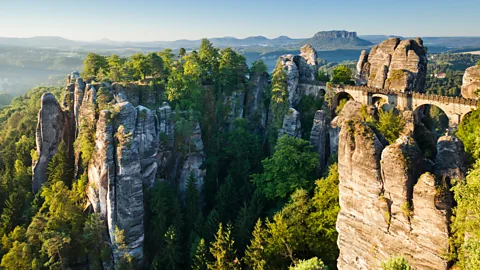 Jorg Greuel/Getty Images
Jorg Greuel/Getty ImagesYet, outdoor lovers might want to consider getting off the train a few stops earlier in Bad Schandau just before 09:00. Chances are most international travellers will have never heard of this Saxony town of roughly 3,000 residents. Yet, if you love to travel off the beaten path, it’s arguably the most rewarding stop of the entire route.
Bad Schandau is the rail gateway to Germany’s Saxon Switzerland National Park. With its series of photogenic, waterfront towns set on the enchanting Elbe River and villages connected by the Malerweg hiking trail – a 116km path that wraps its way around the region, climbing some 3,600m along the way – you might think of Saxon Switzerland as Germany’s version of Italy’s famed Cinque Terre.
I’d had been interested in exploring this region since moving to Germany nearly eight years ago, so after hopping off the train at the Bad Schandau rail station, taking the short ferry ride across the shimmering Elbe River and lacing up my trail running shoes, I set out to explore the Malerweg. As an avid runner, it doesn’t get any better than weaving in between the Elbe Sandstone Mountains’ pointed peaks, feeling the air swirling around the valleys of mossy stone before climbing to the top of the Schrammsteine rock formation using a series of ladders for a panoramic view. The Elbe Sandstone Mountains run through the park like a jagged spine, and from atop the Schrammsteine, you can see the pinnacles spilling into the Czech Republic’s adjacent Bohemian Switzerland National Park.
The next day, I set off on a 3km hike along the Malerweg from the postcard-worthy medieval village of Stadt Wehlen to reach what may very well be the highlight of the region: the Bastei, a stunning rock formation formed more than a million years ago that supports the remains of a nearly 1,000-year-old castle. The Bastei has long been a tourist favourite. In 1824, the wooden Bastei Bridge was built to offer hikers the opportunity to explore the rock formation. Demand quickly spiked, leading to a more durable sandstone bridge in 1851.
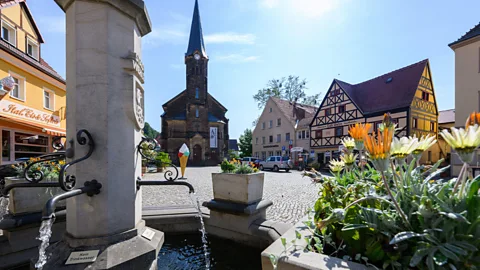 dpa picture alliance/Alamy
dpa picture alliance/AlamyToday, the Bastei draws an estimated 1.5 million tourists annually, making it the most visited place in the German national park system. Yet, the crowds are manageable if you visit in the morning or during the shoulder seasons. It was about 10:00 by the time I reached Rathen, the nearest town and port to the Bastei, and ferries were already packed to the gills with tourists heading up to the Bastei.
Hiking tips
Hiking trails like the Malergweg are well-marked and buses around the Saxon Switzerland National Park and a local train along the Elbe are also available to help you reach the trailhead or get back to your hotel without doubling back on the same route. Most hotels and Ferienwohnungen (holiday homes) will give guests a ticket for unlimited use of regional public transportation, but note that the ferry running across the Elbe at Rathen is privately run and costs €2 to cross.
Hiking and trail running aside, there’s something for all outdoor lovers in Saxon Switzerland National Park. Cyclists can pedal along the Elberadweg, one of the most popular long-distance cycling trails in Germany. The route travels 1,300km from the Czech Republic’s Giant Mountains (Krkonoše, in Czech) to the town of Cuxhaven, paralleling the Elbe River for the entire journey with views of the Elbe Sandstone Mountains. You can also hop on a steam ship for a river tour, or grab a paddle to canoe, kayak or raft down the Elbe River.
After a day of adventures, Bad Schandau is an ideal place to rest and relax – after all, “Bad” (“spa” in German) is in the name. The town’s spa tradition dates back centuries thanks to its therapeutic waters and ample spa facilities. With its lovingly restored villas, it’s an excellent representation of a historical German spa town.
The area surrounding the town’s Kurpark (literally: “spa park”), where a late 19th-Century tram continues to operate, is especially charming. The tram is more of a nostalgic joy ride than a speedy means of transit (the 241 bus covers the same route and in less time). But it’s worth at least one ride to its final stop at Lichtenhain Waterfall, where you can pick up the Malerweg and continue the adventure on foot to the picturesque village of Schmilka. There, head to the Bio-Braumanufaktur brewery and enjoy one of their beers with a hearty bowl of lentil soup.
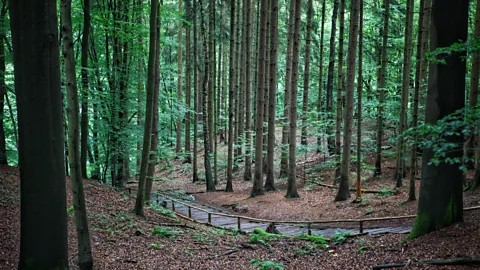 Joe Baur
Joe BaurJust make sure you get back to Bad Schandau in time for the 19:59 European Sleeper train. After a full night’s sleep back on board, you can once again say Goedemorgen to Amsterdam or bonjour to Brussels.
Rail Journeys is a BBC Travel series that celebrates the world’s most interesting train rides and inspires readers to travel overland.

